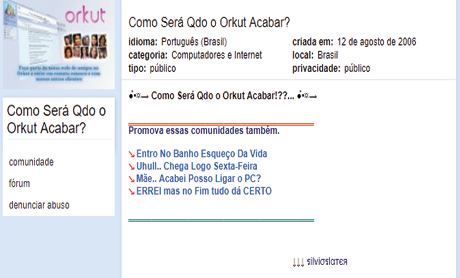The Death and the Death of Orkut
Alice Noujaim
From 2004 to 2010, Orkut reigned supreme in Brazil where it had its main user base. Brazilians were so dominant on Orkut that Orkut’s management was officially transferred to Google Brazil in 2008.
And then came Facebook. Though launched only a month after Orkut—in January and February of 2004—it was only at the turn of the decade that Facebook gained traction in Brazil.
Orkut’s First Death1
In December 2011, Facebook surpassed Orkut as the country’s most visited site.2 By mid 2013, Orkut had lost over 95% of its regular users.3 A year later, with three month’s notice, Google announced it would officially deactivate the website.4
We will shut down Orkut on September 30, 2014. Until then, there will be no impact on current Orkut users, to give the community time to manage the transition.
• People can export their profile data, community posts and photos using Google Takeout (available until September 2016).
• Starting today, it will not be possible to create a new Orkut account.
• Orkut, the service, may be going away, but all of those incredible communities Orkut users have created will live on. We are preserving an archive of all public communities, which will be available online starting September 30, 2014.
• If you don’t want your posts or name to be included in the community archive, you can remove Orkut permanently from your Google account. Please visit our Help Center for further details.
After two or three years of decline, Orkut had become a ghost town, considered to be in a vegetative state, almost dead due to the abandonment of the user base that had migrated en masse to Facebook. Orkut was left behind and Google chose death by official ending, rather than pay for the ongoing maintenance of a neglected space.
When Google took action in June 2014 and declared it was pulling the plug, Orkut’s death protocols were shared with the user base: they had three months of use, three months to export their photos to Google+, two years to export their data, if they did not want to appear in the community archive, they needed to permanently delete their Orkut profile before the September deadline.5
Orkut’s Prime
In its decade of existence, Orkut (2004–2014) forever changed the Brazilian cultural landscape, introducing tens of millions of people worldwide—mainly from Brazil and India, but also from other countries—to their first social network. Created by Turkish Google software engineer Orkut Büyükkökten, whose given name baptized the website, it was also Google’s first step into social media.
Orkut’s architecture predated the newsfeed and was a combination of a dating website—with profile categories such as hair and eye color, drinking and smoking habits, and “what I’ve learned from past relationships”—and forums through its “communities.” Though Orkut never gave up on its romantic relationship-oriented aspects—even introducing a proto-Tinder feature which notified you and your crush if you were in each other’s “crush list”—its defining characteristic were its forum-like communities.6
Orkut communities had various uses and approaches. Eu odeio acordar cedo [I hate waking up early], with over 6 million participants, was a community whose main goal was to function as an extension of profile descriptions. Other examples include Eu amo minha mãe [I love my mother] and EU AMO CHOCOLATE [I LOVE CHOCOLATE].
Then there were humor-based communities that included puns, nonsequiturs, ironic titles, historical jokes, and joke formats that played with title and description. The Eu amo trabalhar [I love to work] community described itself as something like “I don’t, but maybe my boss will see I’m in this community and it will reflect well on me.”
An example of Orkut’s recursive humor was how the community Sou legal, não to te dando mole [I’m being nice, not hitting on you] led to Não sou legal, to te dando mole [I’m not being nice, I’m hitting on you], Você tá sendo legal ou tá me dando mole? [Are you being nice or hitting on me?], and (a personal favorite) Sou mole, não to te dando legal [I’m being hitting, not nicing on you].
And then there were the interest-oriented communities, which functioned as traditional internet forums, but at a then-unprecedented scale. Discografias [Discographies] was the most popular community of its kind, considered to be a precious repository of music where people exchanged files, information, and mutual interest in artists. Because of antipiracy laws, Discografias was shut down in 2009 (with over 900 thousand participants) and entered a sleeping mode until Orkut’s end. Communities were a world that grew on that platform.7
With the end of Orkut and the deletion of their profiles, Orkut’s users faced the responsibility of memory-keeping. Destruction can have the effect of strengthening awareness and memory of what is lost, as suggested by art historian Dario Gamboni:
Destruction, therefore, does not suffice—any more than does preservation—to guarantee permanence. But it can contribute to it, and this is enough to challenge the equation between destruction and oblivion and to justify a theoretical distinction between memory and material survival.8
The action of archiving invites and can even require appraisal, making decisions on what stays and what goes. Daily internet use involves little discarding, as we generate information and files and are encouraged not to delete, but rather to amass storage space. While Google did encourage users to preserve their Orkut memories on a Google Drive through Google Takeout (a self-serving and expected move), many took the Orkut announcement as an opportunity to revisit their (by then mostly abandoned) profiles and make a selection.
The local storage of individual profiles became a duty of care for the digital memory of oneself. But these are personal files, the types of files that are not to be shared.
Those who missed the two-year deadline regret it: according to Google Trends, the search engine is still recording demand for search terms related to recovering photographs from Orkut—these searches spike whenever there’s a “10-year challenge” trend on social media.9
Both Google and the user base understood that the most important thing about Orkut were not the individual profiles and all of its associated interactions through scraps, testimonials and photos— which were also rich, varied, and impacted the lives of millions—but the collective spaces of interaction, the communities. In total, there were 120 million topics among 51 million communities.10 The community archive had a specific protocol of adaptation from one life state to another, which cemented the status change from living to dead: no new content could be generated. No one could respond or edit their old responses in any community. What was still possible was to report content (such as hate speech or copyright violations), asking for it to be removed. Subtraction remained a feature, but nothing more could be added.

Screen capture of the community “What will it be like when Orkut ends?” created in 2006
Communities were collective experiences, which gathered people from different regions through mutualities, through shared humor and interests. Within them, people, known and unknown, got together, talked, joked, forged friendships. The social network was where many tested and developed new social protocols, since Orkut was by far the biggest and most accessible opportunity for Brazilians to meet people on the web. At the time, there was even a new category of gathering called orkontro which described IRL meetings of groups which had met on Orkut.11 It was through the communities, by reconnecting with friends, strangers, web-friends, etc., that Orkut was defined. Those unlikely social interactions—which obviously also included spam, hate speech, harassment, trolling—were the jewel of Orkut.
Orkut’s Second Death
The preservation of the collective over the individual, the communion over the vanity, was a little triumph that ultimately did not last for long. Google maintained the Orkut community archive for just over two years. In 2017, the archive was deactivated, changing the memory-keeping of these Orkut-based interactions from centralized, corporate custody to decentralized, in which different people, in a more-or-less organized way, recorded what they had found interesting.12
The 2017 archive deactivation process was handled in a markedly different manner from the original Orkut shutdown: Google announced it only two weeks in advance and presented no offloading options. It was reported in the media as a “last goodbye,” but with fewer articles and emphasis than when the social network had shut down in 2014. If you saw the announcement when it was made, you had two weeks to make screen captures or copy files to a different place, with no Google guidance.
While two years earlier Google had declared the community archive was for “eternity” and executed a careful protocol of deactivating a living thing, the memorial of that living thing they created was given a rushed ending. Google offered no public explanation on why it was so quickly shutting down an archive considered a significant repository of 2000s web interactions. Orkut had a good death—its archive had a bad one.
Among the reasons for the deactivation of Orkut one can find in the Brazilian media is that Orkut was popular mainly in Brazil and India and that Google was interested in broader, worldwide adoption like it’s rival Facebook. For that purpose, Google invested in Google+ as their social network.13 They aimed for world domination and instead Google+ fell flat into irrelevance and was shut down by Google in 2019 after just five years.14 This does, however, express a general impression that the Community Archive that was promised for posterity was killed off a little over two years later with a two-week notice because the preservation of a collective memory that affected primarily Brazil and India was perhaps simply not reason enough.
Born-digital artifacts are notoriously difficult to preserve in the long-term in the continuous battle against obsolescence and changing technology. Digital objects are tied to infrastructural dependencies, both soft and hard, with multiple conceptual decisions that affect the manner in which they will (or should) be preserved. Art conservators routinely declare that preserving a ten-thousand-year-old object is much easier than a ten-year-old digital object. Indeed, while many paper documents over a thousand years old have made it to today, digital archives must regularly migrate to newer formats to prevent the dreaded broken file icon that signals the loss of accessibility.
When Google assembled the Orkut community archive, it seemed like it had everything needed to keep the promise of preservation. First, Google had clearly defined the parameters of what was being preserved (the communities and the interactions they harbored) in a way that satisfied the community. Second, the archive had the promise of sustaining enough corporate interest as Google’s first social media experiment to keep conservation going.
The announcement of the archive’s death made less noise than when the platform itself had been shut down, though. In retrospect, it is startling to notice the difference in treatment and the low importance devoted to shutting down an archive. No motive was given, just a thank you and a goodbye. There was no outcry over Google’s abandonment of such an archive, no significant popular appeal against the shutdown. As artist and software developer Sarah Friend argues in her essay Good Death, “protocols live through attention, and they die by neglect.”15 The death of the community archive was a second death, in which the destruction of a memorial was handled with disregard and made little noise. Neither with a bang nor with a whimper. Odder still, not many people seem to remember that the Orkut community archive existed.
Even today, however, you can still find screen captures from Orkut communities in news reports, Tumblr feeds, and scattered Twitter posts. Orkut’s memory lives on, even without material proof: in informal conversations people still fondly remember their interactions on Orkut, some of the communities they were a part of, and shared moments that took place there. Naturally, since Orkut was on the web, if one cares to look for evidence, the afterlife’s afterlife is memorialized in the Internet Archive, where it can still be found with a little effort.16 Δ
Alice Noujaim is an anthropologist who works with non-profit organizations in the areas of education, culture, and politics. She holds a Master’s in Museum Anthropology from Columbia University and her research interests include institutional dynamics of archiving, digital preservation of open-ended objects and places, and infrastructural dependencies in art. Based in São Paulo, she is a researcher at Plataforma Democrática and a member of research collectives micro-histórias and Infrastructural Dispositions. www.linkedin.com/in/alice-noujaim-teixeira-767914140/in
-
1. The title of this essay is in reference to Jorge Amado’s A Morte e a Morte de Quincas Berro D’água (1959), translated to English as The Two Deaths of Quincas Wateryell (1965) and later as The Double Death of Quincas Water-Bray (2012). The book is a likely major, though not credited, influence on the film Weekend at Bernie’s.
-
2. “Facebook passa Orkut e vira maior rede social do Brasil, diz pesquisa,” Tecnologia e Games, January 17, 2012. g1.globo.com/tecnologia/noticia/2012/01/facebook-passa-orkut-e-vira-maior-rede-social-do-brasil-diz-pesquisa.html
-
3. Fernanda Morales, “Orkut perde 95,6% dos acessos no Brasil em três anos, afirma pesquisa,” Canaltech, May 22, 2013. arquivo.canaltech.com.br/redes-sociais/Orkut-perde-956-dos-acessos-no-Brasil-em-tres-anos-afirma-pesquisa/
-
4. Paulo Golgher, “Tchau Orkut,” Orkut Blog, June 30, 2014. web.archive.org/web/20140630142637/http://en.blog.orkut.com/2014/06/tchau-orkut.html
-
5. Orkut, “Time to Say Goodbye to Orkut,” Orkut, July 14, 2014. web.archive.org/web/20140715005743/https://support.google.com/orkut/answer/6033100
-
6. For a review of the development of online dating platforms, see Shreeda Segan, “Dangerous Dating Protocols,” Summer of Protocols, 2023. summerofprotocols.com/research/dangerous-dating-protocols
-
7. For more on world growth and death, see Sarah Friend, “Good Death,” Summer of Protocols. summerofprotocols.com/research/good-death
-
8. Dario Gamboni, ‘‘Preservation and destruction, oblivion and memory,” in Negating the Image: Case Studies in Iconoclasm, Anne L. McClanan and Jeffrey Johnson, eds. (London: Ashgate, 2006).
-
9. Ana Letícia Loubak, “Orkut era lançado há 15 anos; relembre curiosidades e polêmicas da rede,” TechTudo, January 23, 2019. www.techtudo.com.br/listas/2019/01/orkut-era-lancado-ha-15-anos-relembre-curiosidades-e-polemicas-da-rede.ghtml
-
10. TudoCelular, “O último adeus: Google encerrará o arquivo de comunidades do Orkut este mês,” TudoCelular, May 2, 2017. www.tudocelular.com/curiosidade/noticias/n92459/orkut-encerramento-pagina-arquivo-comunidades.html
-
11. A portmanteau of Orkut with encontro, the Portuguese word for meeting or gathering, something akin to orgathering.
-
12. Paulo Golgher, “Agora é pra valer: tchau mesmo, Orkut,” O blog do Google Brasil, April 28, 2017.
brasil.googleblog.com/2017/04/agora-e-pra-valer-tchau-mesmo-orkut.html
-
13. Rafael Sbarai, “Orkut guarda memória dos brasileiros nas redes sociais,” VEJA, June 30, 2014. veja.abril.com.br/tecnologia/orkut-guarda-memoria-dos-brasileiros-nas-redes-sociais
-
14. As a side note, Google gave people three months to recover their photos and information before deleting everything. “What You Need to Know about the Sunset of Consumer Google+ on April 2,” Google Workspace Blog, January 30, 2019. workspace.google.com/blog/product-announcements/what-you-need-to-know-about-the-sunset-of-consumer-google-plus-on-april-second
-
15. Friend, “Good Death.”
-
16. Orkut, “Arquivo de Comunidades Do Orkut,” preserved by the Internet Archive October 3, 2014. web.archive.org/web/20141003024627/https://orkut.google.com/index.html
© 2023 Ethereum Foundation. All contributions are the property of their respective authors and are used by Ethereum Foundation under license. All contributions are licensed by their respective authors under CC BY-NC 4.0. After 2026-12-13, all contributions will be licensed by their respective authors under CC BY 4.0. Learn more at: summerofprotocols.com/ccplus-license-2023
Summer of Protocols :: summerofprotocols.com
ISBN-13: 978-1-962872-23-2 print
ISBN-13: 978-1-962872-49-2 epub
Printed in the United States of America
Printing history: July 2024
Inquiries :: hello@summerofprotocols.com
Cover illustration by Midjourney :: prompt engineering by Josh Davis
«digital footprints fading into the distance, exploded technical diagram»

